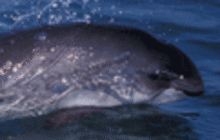
Harbour porpoises are six feet long and weigh about 140 pounds and are the smallest cetaceans found in Canadian waters. The harbour porpoise has tiny flippers and a triangular dorsal fin and a small, rounded head with a short beak and smiling mouth. Harbour porpoises have a black back and a greyish white area extedning from the belly up the the sides in front of the dorsal fin. Harbour porpoises travel at speeds of 14 mph and surface as many as 8 times at one minute intervals.The harbour porpoise dives to depths of 226 meters. Usually harbour porpoises dive for less than five minutes at a time to depths of 30 meters. Great White Sharks and killer whales prey upon harbour porpoises. Harbour porpoises feed upon a variety of fish including herring, pollack, sole, mackerel, sardines and cod. Harbour porpoises also feed upon squid, octopus and small crustaceans. Harbour porpoises possess 19 to 28 small spade-shaped teeth on each side of both jaws.
Male harbour porpoises attain sexual maturity at 3 to 4 years of age while female harbour porpoises attain sexual maturity at between 2 and 4 years of age. Male reproductive strategy is based upon sperm competition and success goes to the male porpoise that produces the most sperm and has the most repetitive matings. Male harbour porpoises have testicles which are equivalent to 7 percent of their body weight and a 45 kilogram male porpoise possesses 3.2 kilogram testicles. Female harbour porpoises carry their babies for ten months ( gestation period ) and mating transpires in July and August. Nursing lasts from 8 to 12 months. Mating with harbour porpoises entails a low reproductive rate with cows that give birth every two years. The harbour porpoise is a gregarious animal that normally lives in small groups of 2 to 5 animals, however it can gather into herds of several dozen to even several hundred animals. Often they travel great distances and have vast territories of thousands of square kilometers over which they can range. About 20 thousand harbour porpoises are estimated to live in the Gulf of St. Lawrence. Most often harbour porpoises are found in bays, harbours, estuaries and river deltas which are ice-free. Marine bio-toxins, dredging, pollution, ship strikes, fishing gear entanglements, becoming trapped in ice and hunting all take their toll upon the populations of harbour porpoises.
Photo by Ari S. Friedlaender, Courtesy of DFO Website: Aquatic Species at Risk - Harbour Porpoise - Northwest Atlantic
